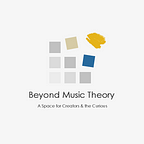Using Secundal Harmony or Chords by Seconds
As we have chords by thirds (or 6th), chords by fourths (or fifths), we also have chords built by stacking seconds (or sevenths). Mind you that the fact that a chord by thirds or fourths has seconds in it, doesn’t make it into a secundal chord — i.e. if you arrange the notes of a C∆ chord like B C E G.
This way of building chords may be a little less usual but it is often found in tone clusters. As in clusters, you will find the possible chord combinations in adjacent tones of the scale you are using, and the possibilities for three note second chords are major-major, major-minor, minor-major and minor-minor:
Contrary to clusters, the pitches in secundal chord formations can be inverted and, when they are, we get sevenths intervals. We can use inversions to control tension with spacing and get milder dissonances. In the example below, you will see the some possible inversions with these chords and in the end, the same chord arranged in sevenths:
Some of the possible inversions of a secundal chord
When this type of chord is executed in close position, they become more percussive in nature due to their harsher dissonance degree. If you are going for that effect, it usually works well in low registers:
Please visit the blog @ https://www.beyondmusictheory.org
